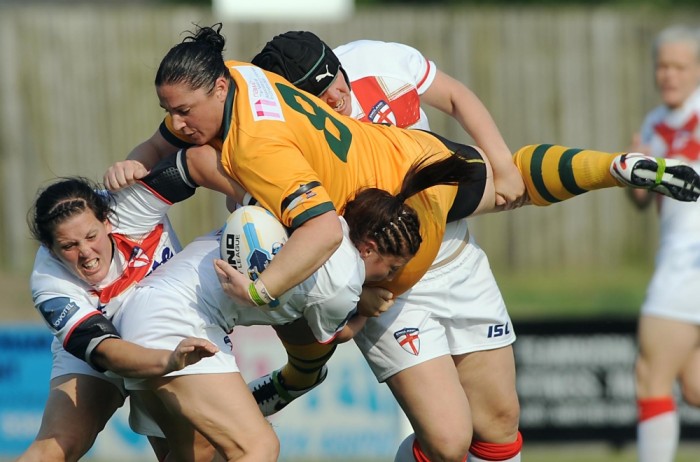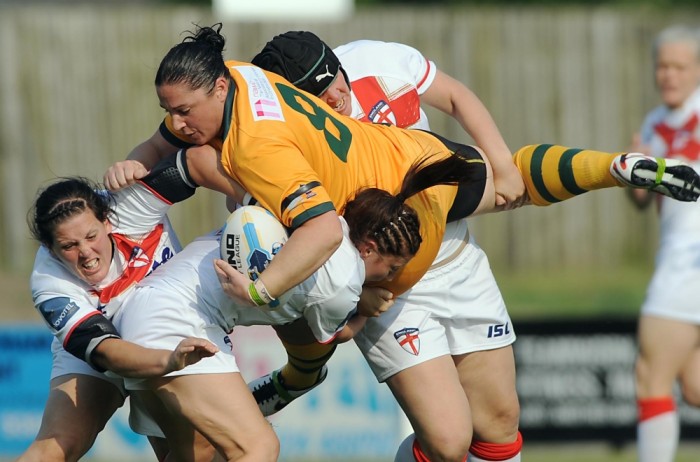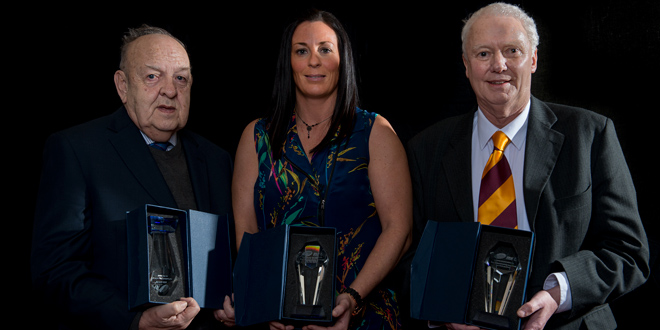
03 Mar How is rugby league attracting all these women?
You might not have heard them shouting but rugby league has a reason to be noisy. The sport is sometimes given a hard time in the media for being rugby union’s poorer, less popular cousin. But off the field some very exciting work is going on to diversify its participants. Incredibly, since 2009 the number of women playing the sport has risen by almost 90%.
Four years ago in its Community Game Strategy, the UK’s rugby league bosses, the RFL, made some bold wishes. They wanted to increase the number of women (aged 16+) playing the sport by 500%. Yes, quintuple, from 3,975 to 19,975. They also wanted a 5% rise in the the number of non-whites involved in rugby league programmes.
So they set about putting measures in place. Their research into the barriers preventing Asian communities from playing rugby league found a perception that many clubs were white-only spaces. As a result, the RFL implemented diversity training to club staff to create more inclusive clubs. They also launched a simpler, more accessible form of the game, touch rugby league, to appeal to people who might not have played the sport before and want an introduction. And it’s proving popular amongst women, despite the number of women playing sport in England falling compared to this time last year. If you look at Thatto Heath, one of the top women’s rugby league sides in the country, their women players have almost doubled since 2009, rising from 377 to 708 registered participants. The RFL also encourages community clubs to host ‘open days’ to improve participation at grassroots level.

England’s women rugby league players (in white) lay down the law to Australia during the 2013 Women’s World Cup (c) RFL
It’s also refreshing to see the RFL making a genuine effort to lessen the barriers for lesbian, gay, bisexual and transgender (LGBT) people who want to be involved in the sport. Information packs were distributed to rugby league clubs to assist with tackling homophobia and a LGBT online forum was created for all RFL staff, players and coaches. The RFL won LGBT charity Stonewall’s Sports Award in 2012 as a result.
But. Growing numbers doesn’t disguise the fact that the women’s game in this country still has a lot to do. The women’s world cup was hosted in England last year with very little fanfare and, whilst their England equivalents in cricket have just turned professional and the footballers have been semi-pro for a few seasons, it seems highly unlikely for rugby league’s women.
“Sky are yet to show a women’s rugby league game,” England and Thatto Heath forward Emily Rudge tells Women Who Like Sport. “And it does not look like that is about to change any time soon so I think we are still a way off ever having any professional women rugby league players.”
Rudge was lucky enough to be exposed to the sport from a young age. Usually, netball is the default sport for girls in school but Rudge’s primary school allowed her to play the game for the first time when she was just 10 years old. She hasn’t looked back since: “I was captain of the girls school rugby team and we were extremely successful. We made it to the National Champions School tournament final all five years we were at school and won it four of the times.
“The school I went to was very supportive of the girls team and therefore my experience of school rugby was hugely positive. Because there were a number of girls in the school that played there were never any negative comments about us. It was just accepted, which was great,” says 22-year-old Rudge, who is studying to be a PE teacher at Liverpool John Moore University.
https://twitter.com/Her_RL/status/391969372832428032
It’s a familiar tale among women who play sports. If they had a positive experience playing sport in school, they are much more likely to continue playing into adulthood. Rudge’s early exposure to the sport led to her becoming the youngest player to represent England in a world cup in 2008.
“The first time I played for England it was on the day before my 17th birthday,” says Rudge. “I wasn’t actually as nervous as I expected to be. All my family was in the stands waving their flags and cheering me on, which I also took a lot of strength from. I absolutely loved the game even though we lost and I walked off the pitch with a massive black eye. It is still one of my favourite memories of my rugby career.
“It’s such an amazing sport once you get in to it. A lot of women and girls just don’t get the opportunity to take part as much as they do with other sports, such as netball and football for example,” Rudge tells Women Who Like Sport. “I think the promotion of touch rugby league will definitely help increase participation but there still needs to be more opportunities in schools for girls to experience how brilliant rugby actually is.”

England legend Natalie Gilmour (centre), who has appeared on every tour and in every international tournament since 2000, becomes the first woman player to be inducted into the Roll of Honour (c) RFL
Whilst Rudge admits professionalism of the women’s game is a while off, smalls gains have been made in recent years. England legend and captain Natalie Gilmour, who recently became the first woman player to be inducted into the rugby league Roll of Honour, has witnessed those improvements. “I remember the first time I was selected for Great Britain’s tour to New Zealand [in 1998], each player had to find £2000 to fund it,” Gilmour tells Women Who Like Sport.
“Now all tours are funded by the RFL, which is a big pressure off the players shoulders. We still have to pay for bits of kit and travel expenses but that’s a fraction of what it used to be. The next step would be for players to be funded by the rugby league so they can work part time and devote more time to training,” says Gilmour who is sister to Castleford Tigers centre Lee Gilmour.
Without funding Natalie has always had to work alongside her 15-year international career, balancing representing her country with the demands of working in the Police Firearms Department. That is the reality for all women’s rugby league players in the UK. But with governing body the RFL being so proactive in recruiting more women into the sport and growing the game, hopefully it won’t be the reality for too much longer.

No Comments